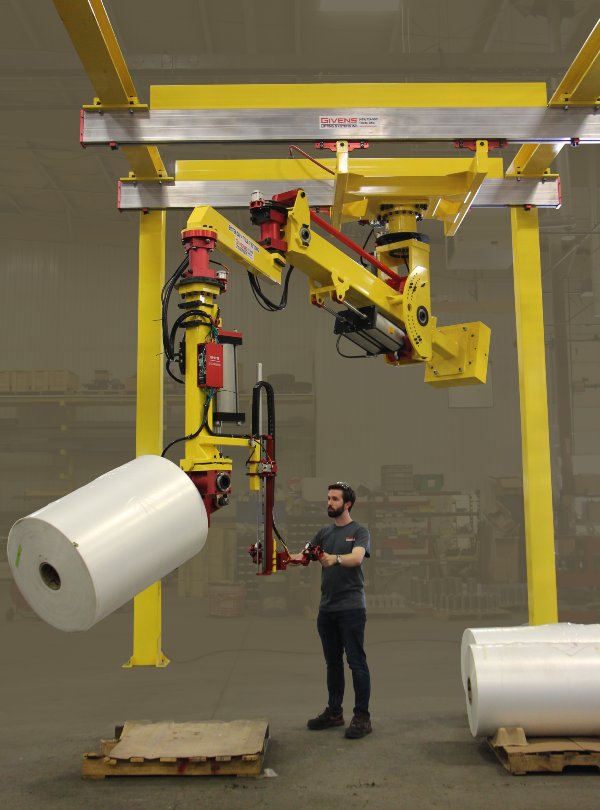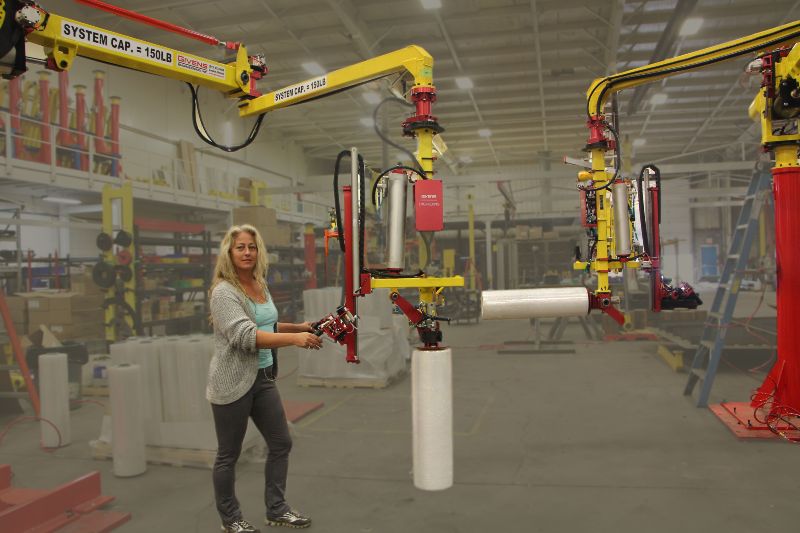What is Roll Handling Equipment and How Does It Work?
Roll handling equipment refers to specialized tools and machinery designed to lift, rotate, transport, and position rolls of various materials, like paper, film, fabric, and tape, safely and efficiently. Whether you’re working with heavy industrial rolls or lightweight material spools, this equipment ensures precision and control during handling.
A roll manipulator or roll gripper can be mounted on a manipulator arm or suspended from custom cranes for roll handling, depending on your operational needs. From pneumatic tilting systems to adaptable end effectors, roll equipment is essential for improving workplace ergonomics, reducing product damage, and increasing productivity. Givens Engineering offers both standard and custom roll handling solutions, tailored for various industries requiring consistent, safe roll transfer.
Custom Cranes for Roll Handling
Roll handling end effectors grip the inside of fiberboard or plastic roll cores
- After gripping, the roll can be tilted 90 degrees pneumatically
- The roll handler shown is mounted on a manipulator, but it can also be hung from a crane
- Roll Weights Up to 2,000 lbs
- Inside Roll Diameter 3 & 6 inches
Gripping
The inside of a roll is gripped with 3 jaws arranged at 120 degrees, each equipped with serrated teeth. The teeth make very slight marks in the interior of fiberboard cores. Gripping is done pneumatically, with an air cylinder that is outside of the roll. The grip is strong enough that there would be at least a 2:1 safety factor against release when the roll is held vertically.
Roll Orientation
Rolls can be picked up vertically (“eye-to-the-sky”) or horizontally. Rolls can be pulled from a horizontal mandrel or set on a horizontal mandrel.

Roll Handling Guidelines & Precautions
Roll Weight and size compatibility
The maximum weight of roll that can be picked up is limited only by the inside diameter of the roll relative to its length. For example the maximum weight for a roll with a 3” ID and a length of 60” is limited by the strength of the shaft that could be inserted inside. A 6” ID roll with a length of 30” could have a much larger weight. Roll weights up to 2000 lb can be handled, dependent on the roll ID. Heavier rolls can be lifted with custom shafts.
Pneumatic Safety Systems
If air pressure is lost while the roll is hung, a pilot-operated check valve will hold the load long enough to bring it to the floor. The structure of the roll handler has a safety factor of about 3:1.
Crane-Mounted Roll Handling
The roll handler can be hung from a crane or from a manipulator. When a roll handler is hung from a crane and 90 degree tilting is required, a load leveler can be added depending on the size and weight of the roll. The load leveler is a device that actively moves the crane hook point under pneumatic power to level out the roll after tilting.
Manipulator Roll Handling
When rolls are lifted with a manipulator (as in the photos here) handling is very convenient because the roll can be brought to a perfect horizontal or vertical position regardless of the size or weight of the roll, and regardless of where the center of gravity of the roll has moved to. Manipulators can also reach underneath other rolls in an array in an unwind machine. They also float the load, so that up/down push-buttons are not required.
Handling Extremely Heavy Rolls
Rolls that weigh several thousand pounds (that do not have to be rotated) can be lifted by inserting shafts in either end of the roll.
Roll Handler Shaft Length
The length of the roll handler’s shaft can be varied by pulling a pin and swapping shafts.
Loading Rolls onto Mandrels
Special consideration should be given to the tight clearances between the ID of a roll and the diameter of the unwind mandrel that the roll is being loaded to (or unloaded from). If the loading is being done with a crane, it may be very easy to bind the roll on the mandrel. It may not be obvious whether it is necessary to press up or down on the crane pendant, possibly worsening the binding. However, if the roll is suspended from a manipulator, shown above, and the roll weight is less than 300 lb, the manipulator can ‘float’ the load, without up/down pushbuttons. The weight of the roll is perfectly balanced by the manipulator arm. In this situation, the operator moves the roll up and down by pulling on the handlebars, and can ‘feel’ the roll slide over the mandrel. Binding is almost impossible because the roll can never be forced upward or downward against the mandrel, except to the extent that the operator can with his own hands.
Mobile Roll Handling
If there are many machines to be loaded, separated by some distance, then the roll handler can be mounted on a crane with long travel. Or, the roll handler could be mounted on a mobile manipulator. For example, the manipulator could have a very heavy base that could be moved by fork-truck. Or, for light rolls, the manipulator could be mounted on a pallet cart or “walkie”.
Examples of Roll Handling Equipment Solutions




Other Roll Handling Applications & Equipment
- Barrel Handlers
- Custom Hooks
- Slings
- Forklift Attachments
- Magnetic Lifters
- Load Leveling Devices
- Pallet Lifters
- Vacuum Lifts
- Sheet Metal Lifters
- Coil Hooks
- Stainless End Effectors
Improve Workflows with Givens Engineering’s Roll Handling Equipment
Givens Engineering is an innovative engineering company building a wide variety of cranes, manipulators and material handling equipment. We are located just off the 401 in London, Ontario and only a two-hour drive from Toronto, Ontario and Detroit, Michigan. Whatever your material handling requirements, we can offer a solution.
Have any questions about our roll handling capabilities?
